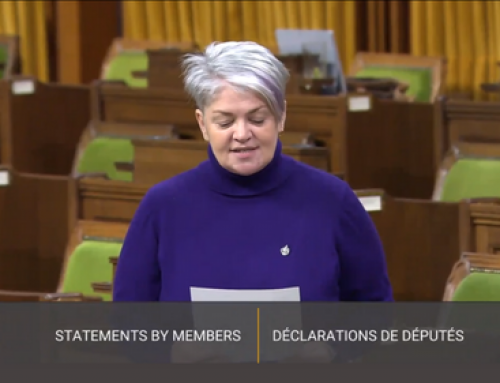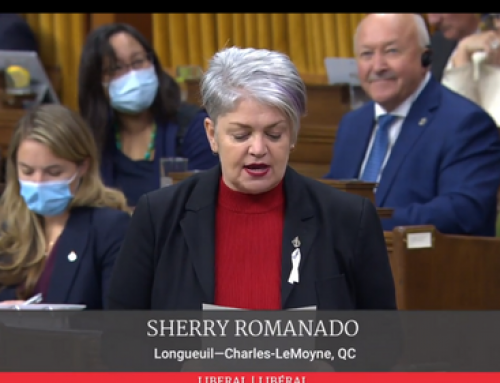Transcription
Mr. Speaker, I rise to speak to private member’s bill, Bill C-211, an act respecting a federal framework on post-traumatic stress disorder.
Bill C-211 was introduced by the member for Cariboo—Prince George and calls on the Minister of Health to spearhead a concerted effort aimed at developing a federal framework to address a complex issue.
I would like to thank the member for Cariboo—Prince George for bringing this to the House. I would like to take a moment to talk about the important issue of post-traumatic stress disorder, otherwise known as PTSD in Canada.
As the daughter and spouse of firefighters, and the mother of two serving Canadian Armed Forces members, the issue of PTSD is a personal one for me. We have come a long way in our collective understanding of PTSD since it was first added to the Diagnostic and Statistical Manual of Mental Disorders by the American Psychiatric Association in 1980.
This addition was a significant turning point, because it formally acknowledged PTSD as an acquired mental health condition rather than a personal shortcoming. During the last decade, neuroimaging studies have reaffirmed that PTSD is real and measurable. Researchers can now observe the brain circuits that mediate this disorder.
Unfortunately, sensational media coverage has helped perpetuate the stereotype that people with PTSD are psychotic and violent, which is an inaccurate portrayal of this mental illness.
A traumatic event involves exposure to actual or threatened death, serious injury, or sexual violence. It may be a one-time incident or involve sustained or repeated exposure.
Exposure can involve experiencing the traumatic event first-hand or witnessing or hearing about a traumatic event that happened to others.
The traumatic event or events completely wipe out the individual’s capacity to deal with or process the thoughts and emotions related to the incident.
Events that may be associated with PTSD include combat exposure, childhood abuse, sexual assault, and physical violence. Many other traumatic events can be associated with PTSD, such as natural disasters, intimate partner violence, and other extreme or life-threatening events. PTSD can develop immediately after someone experiences a disturbing event, or it can develop weeks, months, or even years later.
According to a 2008 study, about 9% of people in Canada will experience PTSD at some point in their lives. This is consistent with the worldwide prevalence, which ranges between 7% and 12%. Studies show that females are twice as likely to develop PTSD compared to males, but males are less likely than females to seek help. Children and adolescents also experience this disorder, and genetics may make some people more likely to develop it than others.
We also know that certain populations are at increased risk for PTSD because their jobs expose them to extreme and traumatic events that may be recurring. While many associate PTSD with military service, it can manifest in first responders, firefighters, corrections officers, emergency room personnel, victims of crime, and members of the RCMP.
The few studies that have been conducted indicate that between 10% and 35% of first responders will develop PTSD, and the lifetime prevalence of this disorder among active members of the Canadian Armed Forces is 11%. Unfortunately, there is not enough quality data to provide a clear and complete picture of the prevalence, and social and economic impacts of PTSD in Canada.
Collecting quality data on the prevalence and impact of PTSD in Canada is only part of the solution. Another important aspect is raising public awareness about this mental illness.
Although Canadians have become much more aware of this problem in recent years, there are still gaps in their knowledge and understanding of PTSD symptoms and treatment.
As with many other mental illnesses, a big problem is that, unfortunately, the stigma associated with PTSD prevents many people from getting help and prevents others from recognizing the symptoms associated with this mental illness.
Developing PTSD is not a sign of weakness. Many factors play a part in whether a person will experience PTSD, and it will manifest itself differently for different people. Risk factors make a person more likely to develop PTSD, while protective factors can help build resilience and reduce the risk of developing this disorder.
Risk factors include having prior trauma, having been abused as a child, having pre-existing mental health issues, and having a family history of mental illness. Other socio-economic risk factors include lower levels of income and education, and being from an ethnic minority. Following a traumatic event, people who lack social supports are also at a higher risk.
Protective factors include seeking and receiving support from friends and family, finding a support group, and having positive coping strategies. Researchers study the importance and interplay of risk and protective factors. Their findings continue to inform our understanding of PTSD, including the development of effective preventive and treatment approaches.
While symptoms vary from one individual to the next, those affected by PTSD often relive a traumatic event they experienced either through flashbacks and nightmares or by being exposed to situations that trigger memories of the traumatic experience. Some symptoms include negative thoughts, feelings of isolation or distress, and lack of reaction or fear.
People with PTSD might also have sleep disorders, anxiety, and depressive behaviour, or feel paralyzed at the thought of doing the simplest task.
It is also common for individuals with PTSD to self-medicate by using drugs or alcohol.
With such a range of symptoms, it is not surprising that this disorder can also reduce a person’s ability to function in relationships, at work, and in leisure activities.
Without proper treatment, the symptoms of PTSD can get worse and have lasting and devastating effects including substance abuse, chronic pain, hypertension, self-mutilation, and suicide.
Growing evidence shows that early treatment of trauma symptoms may reduce the risk of developing PTSD. This suggests that identification and early intervention using evidence-based treatments is critical to preventing this disorder. PTSD affects people differently, so a treatment that works for one person may not work for another. Some people with this disorder need to try different treatments to find what works for them. Recovery is more complicated for people who have endured repeated trauma, and for those who were traumatized early in life.
The idea is to develop more personalized, effective, and efficient treatments, and possibly even to prevent the disorder from ever manifesting.
Diverse areas of research continue to provide pieces of the puzzle bringing us closer to understanding the whole picture of PTSD. I am inspired by the work done on PTSD, not only by federal departments but also by provinces, territories, and advocacy groups across this country.
We need to come together to break the stigma and to allow those suffering, and the families who suffer along with them, to get the help they need. Today, we come together, we put partisanship aside, and we support our everyday heroes.
I very much appreciate the opportunity to speak about this important issue in the House of Commons.






Leave A Comment